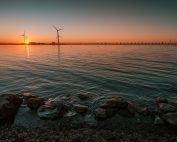The year 2022 was full of events that are permanently changing the conditions for the offshore wind industry. We asked industry leaders and key policy-makers for their assessment of what has been achieved in the past year and what the forecasts are for 2023. In today’s interview of the „Baltic Sea Offshore Wind – 2022 Summary & 2023 Outlook” series, we present the opinion of Jaidev Dhavle, Associate Programme Officer – Innovation for the Energy Transition in the International Renewable Energy Agency (IRENA).
2022 Summary
From my perspective the most important developments for the offshore wind industry in 2022 are as follows:
Offshore wind technology has matured rapidly since 2010. Our most recent analysis found that was an eighteen-fold increase in cumulative deployed capacity between 2010 and 2021, from 3.1 GW to 55.7 GW (IRENA Renewable Power Generation Cost Report 2021)
The leading offshore wind market driver has been Europe, but recently China is rapidly picking up with about 17.4 GW of additional capacity installed in 2021 alone – Asia is projected to account for 60% of new installed capacities in 2050. (IRENA World Energy Transition Outlook 2022)
Offshore wind continues to become a cost-competitive technology. In 2021, the global weighted average levelized cost of electricity (LCOE) of offshore wind has declined by 60% between 2010 and 2021, from $0.188/kilowatt hour (kWh) to $0.075/kWh. Denmark had the lowest weighted average LCOE for projects commissioned in 2021, at $0.041/kWh. (IRENA Renewable Power Generation Cost Report 2021)
Projects such as the Maasvlakte 2 in Rotterdam are promoting the coupling of Offshore wind with electrolysers to produce green hydrogen due to the underlying potential of reducing costs and providing a clean energy source for different activities. (IRENA Offshore Renewables: An Action Agenda For Deployment 2021)
The EU has acknowledged that fast permitting is necessary to unlock the potential offshore wind. In December 2022, the EU-27 Ministers have approved new rules wherein Member States must accelerate permitting for all new wind energy projects. They must now permit repowering projects within 6 months, including the Environmental Impact Assessment and the grid permits. If repowering results in a capacity increase of less than 15% then the grid connection shall even be permitted within 3 months. These rules can also be applied to wind project under development.
Our main achievements in 2022 has been the launch of the Global Offshore Wind Alliance (GOWA). The alliance, initiated by the International Renewable Energy Agency (IRENA), Denmark and the Global Wind Energy Council, will bring together governments, the private sector, international organisations and other stakeholders to accelerate the deployment of offshore wind power. 9 countries have joined GOWA and have agreed to work together to drive national, regional, and global ambitions and remove barriers to the deployment of offshore wind in new and existing markets. In addition to GOWA, our Collaborative Framework on Ocean Energy & Offshore Renewables has been fostering discussion and exchange of best practices to promote offshore wind solutions among IRENA Membership.
2023 Outlook
An important challenge for offshore wind development in 2023 is going to be the development of permitting process that are dynamic as current protocols are slow. Some of the key challenges that hamper permitting process are the variety of different permits to be acquired before a project can be initiated; the lengthy permitting lead times required; and opposition to projects because of environmental concerns. Establishment of dedicated central authorities; Effective stakeholder consultation channels; and introducing legislation to mandate maximum lead times for permits are key solutions proposed. (IRENA-GWEC Brief on Accelerating Permitting – forthcoming)
In 2023 we will focus in particular on managing the activities of GOWA to accelerate offshore wind solution deployment. We will also be undertaking further research and organization of events on the following topics marine spatial planning; grid integration; or coupling offshore with Power-to-X.














